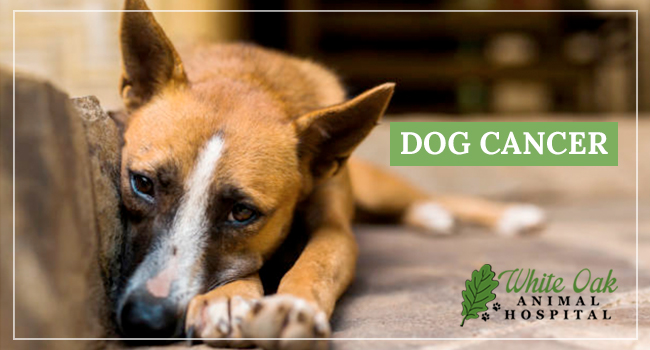
Dog cancer is an unfortunately common malady.
Common causes of dog cancer include environmental pollution, diet, genetics and inbreeding.
Dogs who show obvious signs of illness should be evaluated by a veterinarian to determine a diagnosis.
If your pet is diagnosed with cancer, luckily there are numerous treatment options available.
How Is Dog Cancer Diagnosed?
Only a veterinarian can diagnose dog cancer.
Consult your veterinarian if your pet experiences any of the following symptoms.
What Are The Symptoms of Dog Cancer?
Dog cancer often mimics the appearance of more benign ailments.
If your pet experiences any of the following symptoms, consult your veterinarian to confirm a proper diagnosis.
Once a diagnosis is given, your veterinarian can offer a variety of treatment options.
Pain
Dogs in pain typically show signs such as limping or whining when getting up or walking.
They may appear lethargic.
Pain is often a sign of injury or arthritis, but may be a sign of bone cancer.
Incontinence
House-trained dogs that begin to have accidents could have a bladder infection or UTI.
Bring in your pet to see the veterinarian if there is blood in their urine or stool.
These signs may be bladder cancer.
Lethargy
Energetic dogs who suddenly become lazy or lethargic should be examined for illness.
Changes in Appetite
If your dog refuses food or water, bring them in to see the veterinarian.
Cancer of the mouth, esophagus or digestive tract can cause appetite loss.
Difficulty Breathing
Dogs with lingering coughs or difficulty breathing should be seen by a vet.
Heart and lung disease, or lung cancer, can cause these symptoms.
Weight Loss
Dogs with sudden weight loss accompanied by any of the other symptoms on this list should be evaluated by their veterinarian.
Open Wounds
Dog skin cancer may present as an open wound that won’t heal.
Lumps or Bumps Under Skin
Aging dogs often grow benign tumors beneath the skin.
These typically grow slowly and feel independent of your dog’s body.
Cancerous tumors usually grow quickly, seemingly appearing overnight.
Also, they feel connected to your dog’s body.
If you notice new or old bumps on your dog, bring him to the vet.
Dog Cancer Treatment Options
If your dog is diagnosed with cancer, there are several considerations to make before pursuing treatment.
Your doctor should present answers to the following questions:
- What type of cancer does your dog have?
- How advanced is your dog’s cancer?
- Is surgery recommended?
Surgery
Depending on the type of cancer, how far it has advanced and your pet’s overall health, surgery may be an option.
Surgery is typically best for dogs who are otherwise in good health.
It is also best for removing encapsulated tumors. Surgery also works for tumors in areas with a low chance of damaging other parts of the body.
Depending on the surgery, recovery can be difficult.
Radiation
Radiation therapy uses radiation that is similar to x-rays to kill cancer cells.
But, it’s not appropriate for every case.
Radiation can have serious side effects depending on how it’s administered.
Chemotherapy
Humans commonly treat cancer with chemotherapy.
Chemotherapy uses chemicals to kill cancer, making it very effective.
However, sometimes it kills healthy cells too.
Immunotherapy
Immunotherapies stimulate immune system responses in the body to fight cancer.
Alternative Therapies
Nontraditional options are often best when used in conjunction with medical treatments.
These therapies include:
- High CBD Hemp Oil
- Herbs
- Supplements
- Special Diets
- High Dose Vitamin C.
More Powerful Tools for Overcoming Dog Cancer Challenges
You might not be aware, but many cancer-fighting tools are easy to get and use at home on your dog.
To realize your true cancer-fighting potential:
- Learn more about dog cancer.
- Ease your dog’s discomfort naturally. PET | TAO Comfort Supplement is a blend of Eastern herbs and Western supplements to soothe your dog’s arthritic challenges to make him/her more comfortable.
- Boost your dog’s immune system with medicinal mushrooms. PET | TAO Complement Immune Supplement is a Mushroom Blend combining the most powerful immune-boosting medicinal mushrooms on the market in a single product.
- Ease your dog’s stomach upset naturally. Many dogs with cancer suffer stomach upset as well. PET | TAO Harmonize GI Supplement naturally provides all the digestive enzymes and probiotics your dog or cat needs for optimum gut health.
- Try PET | TAO Freeze Dried Beef Spleen Dog and Cat Treats. According to TCVM, spleen helps with digestion and assimilation. Both are challenges often faced by pets suffering from cancer. As few as 5-6 treats per day can make a huge difference in your dog’s health!
- Try a Blood-building TCVM Diet. According to TCVM theory, dogs suffering from cancer also often suffer from Blood deficiency. Blood deficiency may be due to chemotherapy or the cancer itself. PET | TAO Zing Formula Canned Dog Food builds Blood.
- Learn more about TCVM Herbal Remedies. Chinese medicine offers many amazing natural solutions for dog cancer challenges and palliative care. Some good examples are: